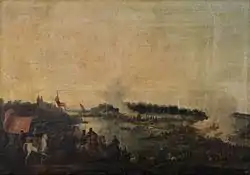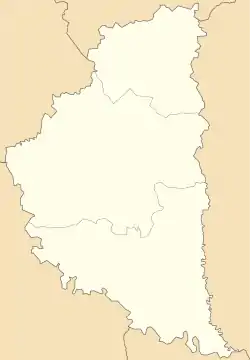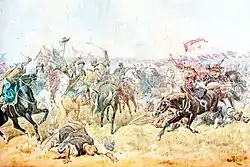Battle of Zboriv (1649)
The Battle of Zboriv (Polish: Bitwa pod Zborowem, Ukrainian: Зборівська битва), during the Khmelnytsky Uprising, was fought near the vicinity of Zborów (village of Mlynivtsi, Ukraine) on the Strypa River, and near the Siege of Zbarazh. The battle was fought between the combined Cossack-Crimean force and the Crown army of the Polish–Lithuanian Commonwealth.
| Battle of Zboriv (Zborów) | |||||||||
|---|---|---|---|---|---|---|---|---|---|
| Part of the Khmelnytsky Uprising | |||||||||
 Painting of Jean-Pierre Norblin de La Gourdaine (1780s) | |||||||||
| |||||||||
| Belligerents | |||||||||
|
|
| ||||||||
| Commanders and leaders | |||||||||
|
Bohdan Khmelnytsky Khan İslâm III Giray | King John II Casimir | ||||||||
| Strength | |||||||||
| 40,000 Ukrainian cossacks 20,000-25,000 Crimean Tatars | 16,000[1]:576 | ||||||||
| Casualties and losses | |||||||||
| Unknown | Unknown | ||||||||
 Location within the Ternopil Oblast | |||||||||

King John II Casimir Vasa and the main Polish army left Warsaw on 23 June and had made it to Toporiv in the final days of July when Mikolaj Skrzetuski (called Jan Skrzetuski in Henryk Sienkiewicz's With fire and Sword) informed the king of the desperate situation at Zbarazh.[1]:575–576 The king made it to within a half-mile of Zboriv on 13 August.[1]:578
The battle
Earlier, on August 9, 1649 Bohdan Khmelnytsky redeployed his main forces from Zbarazh to Staryi Zbarazh to the west where the terrain hid them from the Poles, while he used deception to prevent the besieged from noticing.[1]:578 The Horde, followed by the Cossack Host advanced toward the royal camp during the night of 15 August.[1]:578
The Crown forces were surprised during the rainy and foggy day while crossing the river Strypa.[1]:578 The Horde split into two parts and attacked from the front and the back, but the king rallied his army to repel the attack and the Tatars retreated by nightfall.[1]:578
The night brought a council of war on the Polish side and two letters from the king, one for the Khan and one for Khmelnytsky.[1]:579 The letter to the khan "reminded the khan of the favor that he had enjoyed from the Poles in his youth, while sojourning as a captive...invited the khan to a renewal of their old friendship...receiving money for past, present, and future years."[1]:579 The letter to Khmelnytsky commanded him to "abandon all hostile actions and retreat ten miles from our army, and send us your envoys - what you desire from us and from the Commonwealth."[1]:580
The next day brought more attacks from the Cossacks and the Tatars on two fronts but then a letter from the khan and Khmelnytsky arrived.[1]:581 The khan was prepared to negotiate provided there was "satisfaction of the Cossacks, payment of the suspended tribute...a substantial consideration...above the tribute, as well as permission for the Horde to take captives on its way back."[1]:581 The letter from Khmelnytsky stated, he would "take this occasion earnestly to deliver myself with my humble services beneath the feet of the majesty of Your Royal Highness."[1]:582
The aftermath
On 18 August, the Treaty of Zboriv (Zborów) was agreed upon by Khmelnytsky and the Lord commissioners Jerzy Ossolinski, Lord Crown chancellor, Kazimierz Lew Sapieha, Lord chancellor of the Grand Duchy of Lithuania, Krzysztof Koniecpolski, Lord Palatine of Belz, Stanislaw Witowski, Lord of Sandomierz, and Adam Kysil, Lord Palatine of Kyiv.[1]:589 "It was drafted not in the form of a treaty...but as a unilateral royal manifesto...at the request and intervention of the Crimean khan."[1]:593
References
- Hrushevsky, M., 2002, History of Ukraine-Rus, Volume Eight, The Cossack Age, 1626-1650, Edmonton: Canadian Institute of Ukrainian Studies Press, ISBN 1895571324